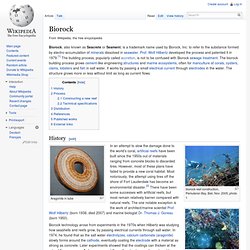

REFLEURIR LE DESERT POUR NOURRIR L'HUMANITE - L'expérience de Tacharane - Agroécologie au Mali. Groasis, let's green the world! Biorock. Biorock. Biorock, also known as Seacrete or Seament, is a trademark name used by Biorock, Inc. to refer to the substance formed by electro-accumulation of minerals dissolved in seawater.

Prof. Wolf Hilbertz developed the process and patented it in 1979.[1] The building process, popularly called accretion, is not to be confused with Biorock sewage treatment. The biorock building process grows cement-like engineering structures and marine ecosystems, often for mariculture of corals, oysters, clams, lobsters and fish in salt water. It works by passing a small electrical current through electrodes in the water. The structure grows more or less without limit as long as current flows. History[edit] Aragonite in tube biorock reef construction, Pemuteran Bay, Bali, Nov. 2005, photo 1 biorock reef construction, Pemuteran Bay, Bali, Nov. 2005, photo 2 Hilbertz originally called his invention, on which he had several patents, underwater mineral accretion or accretion for short.
Process[edit] Distribution[edit] Permaculture in Mecca Permaculture Research Institute. Geoff Lawton reports from a consultation trip to what will become the Al Bayda Project, Saudi Arabia The Al Bayda Project in Saudi Arabia aims to help rehabilitate a large area of land, roughly 35 x 20kms (700km2 in total) containing 9 villages of Bedouin people who have been settled for 20-30 years in very basic conditions.

The main mission is to develop a sustainable design demonstration system for how they can develop their villages and manage their environment and quite large herds of animals. Traditionally they would move with seasonal conditions around good grazing range-land patterns of management. Now, in settled villages, they don’t have the possibility to manage good range-land grazing with the appropriate patterning, and so the environment is greatly suffering from over-grazing and cutting of trees for firewood. As this grazing is their cultural heritage, they are not prepared to let it go and yet they don’t exactly fit into modern systems of settlement either.
Greening the Desert II - Final Permaculture Research Institute. The Greening the Desert II video I shared with you recently was edited in Jordan.

Now that I’m back at my desk again I’ve had time to edit it slightly. I’ve added the original five-minute Greening the Desert clip in to the front of it, to ensure viewers have context for Part II (and we’ve also had requests for both to be made available together), as well as cut a few minutes out of Part II to keep it flowing a little better. You can not only watch online below and embed on your own websites (click for embed code at top right of video screen), but it’s also available for download, so those who’d like to have a ‘hard copy’ to circulate are welcome to download, burn to disk or transfer to USB key, etc., and circulate freely.
Download: You’ll see the option to download the 913 megabyte MP4 file at bottom right side of this page. YouTube: The video can also be watched on YouTube, in four segments, here, here, here and here. A little background on the video follows: Jordan Valley. Net Technologies. The Vetiver Network International (TVNI)